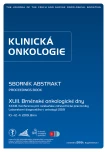Analysis of Blood Plasma MicroRNAs to Enable Identification of Patients with Pancreatic Ductal Adenocarcinoma Who Will Benefit from Surgical Resection
Authors:
N. A. Gabło 1; V. Procházka 2
; J. Hlavsa 2; I. Kiss 3
; J. Srovnal 4; Z. Kala 2
; O. Slabý 1,3
Authors place of work:
CEITEC – Středoevropský technologický institut, Masarykova univerzita, Brno
1; Chirurgická klinika LF MU a FN Brno
2; Klinika komplexní onkologické péče, Masarykův onkologický ústav, Brno
3; Ústav molekulární a translační medicíny LF UP v Olomouci
4
Published in the journal:
Klin Onkol 2019; 32(Supplementum1): 174-176
Category:
Článek ve sborníku
Summary
Background: Pancreatic ductal adenocarcinoma (PDAC) is the most common malignancy of pancreas, characterized by extremely poor prognosis largely due to problem with early diagnosis and lack of progress in personalization of therapy. Of all available treatment strategies, radical surgical resection of the tumour in its early stage remains the only possibility how to reach long-term survival. However, even a technically perfect surgical resection may still not provide a survival benefit for all PDAC patients. Appropriate selection of patients for surgical resection is one the important medical needs in management of PDAC patients.
Material and methods: To this study we enrolled 24 PDAC patients who underwent surgical resection and preoperatively collected their blood plasma specimends. Patients were divided into to two prognostic groups according to their overall survival – 12 patients with poor prognosis (median overall survival 10 months) and 12 patients with good prognosis (median overall survival 25 months). Small RNA sequencing technology was applied to screen for microRNAs (miRNA) with differential levels between both PDAC patient’s group. cDNA libraries were prepared using QIAseq miRNA Library Kit (Qiaqen) and sequencing by NextSeq500 instrument (Illumina).
Results: When miRNA expression profiles of the PDAC patients from good and poor prognostic groups were compared, 61 miRNAs were identified to have significantly different plasma levels between the two groups (p < 0.05). A total of 21 miRNAs showed increased expression and 40 miRNAs showed decreased expression in a group of patients with poor prognosis compared to patients with good prognosis.
Conclusion: This study demonstrated differences in miRNA expression profiles in preoperative plasma specimens of PDAC patients with short and long overall survival. Our observations indicate that after independent validations plasma miRNAs might become useful biomarkers for identification of PDAC patients having clinical benefit from surgical resection of the tumour.
This work was supported by Czech Ministry of Health, grant No. 16-31314A.
All rights reserved.
The authors declare they have no potential confl icts of interest concerning drugs, products, or services used in the study.
The Editorial Board declares that the manuscript met the ICMJE recommendation for biomedical papers.
Submitted: 8. 3. 2019
Accepted: 9. 3. 2019
Keywords:
pancreatic ductal adenocarcinoma – circulating microRNA – prognostic biomarker
Zdroje
1. Vincent A, Herman J, Schulick R. Pancreatic cancer. Lancet 2011; 378 (9791): 607–620. doi: 10.1016/S0140-6736 (10) 62307-0.
2. Ferlay J, Soerjomataram I, Dikshit R. Cancer incidence and mortality worldwide: sources, methods and major patterns in GLOBOCAN 2012. Int J Cancer 2015; 136 (5): E359–E386. doi: 10.1002/ijc.29210.
3. Siegel RL, Miller KD, Jemal A. Cancer statistics, 2018. CA Cancer J Clin 2018; 68 (1): 7–30. doi: 10.3322/caac.21442.
4. Rhim AD, Mirek ET, Aiello NM. EMT and dissemination precede pancreatic tumor formation. Cell 2012; 148 (1–2): 349–361. doi: 10.1016/j.cell.2011.11.025.
5. Gu S, Jin L, Zhang F. Biological basis for restriction of microRNA targets to the 3’ untranslated region in mammalian mRNAs. Nat Struct Mol Biol 2009; 16 (2): 144–150. doi: 10.1038/nsmb.1552.
6. Schanen BC, Li X. Transcriptional regulation of mammalian miRNA genes. Genomics 2011; 97 (1): 1–6. doi: 10.1016/j.ygeno.2010.10.005.
7. Vorvis C, Koutsioumpa M, Iliopoulos D. Developments in miRNA gene signaling pathways in pancreatic cancer. Future Oncol 2016; 12 (9): 1135–1150. doi: 10.2217/fon-2015-0050.
8. Galatenko VV, Galatenko AV, Samatov TR. Comprehensive network of miRNA-induced intergenic interactions and a biological role of its core in cancer. Sci Rep 2018; 8 (1): 2418. doi: 10.1038/s41598-018-20215-5.
Štítky
Dětská onkologie Chirurgie všeobecná OnkologieČlánek vyšel v časopise
Klinická onkologie

2019 Číslo Supplementum1
- Metamizol jako analgetikum první volby: kdy, pro koho, jak a proč?
- Jak souvisí postcovidový syndrom s poškozením mozku?
- Nová šance pro pacienty s pokročilým karcinomem žaludku − kombinace trifluridin/tipiracil
- Nejasný stín na plicích – kazuistika
- Fixní kombinace paracetamol/kodein nabízí synergické analgetické účinky
Nejčtenější v tomto čísle
- Metastazující světlobuněčný renální karcinom bez zjevného primárního ložiska v ledvině imitující pokročilé stadium plicní malignity
- Encyklopedie subsetů CLL – unikátní bioinformatický nástroj a databáze pro analýzu subsetů stereotypních B buněčných receptorů u CLL
- Molekulární klasifikace meduloblastomů pomocí celogenomového expresního profilování
- Analýza mikroRNA v krevní plazmě s cílem identifikovat pacienty s duktálním adenokarcinomem pankreatu mající benefit z chirurgické resekce
